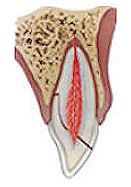DENTAL INJURY
- What is a dental injury?
A dental injury is an injury of one or more teeth of the permanent or deciduous dentition and occurs more often in children and teenagers, as well as in people engaged in sports activities; dental injuries consist 5% of injuries. According to a 12-year research, 25% of children of age of 6-18 years and 33% of adults have injured their teeth. A fall on the floor, an accident while playing a game, a car accident and school fights are the main causes of such an injury. As a high risk group are considered people whose teeth have a high overjet. The types of dental injuries are many and, depending on the case, the required treatment is different. As this is a quite complicated matter, regarding both its diagnosis and its treatment, a visit to a Dentist-Endodontist is deemed necessary.
- I fell down and broke my tooth, what should I do?
After a hit, apart from the possibility that the tooth moves, there is also the danger that the tooth cracks or even breaks. You must immediately visit a dentist. If the problem is relatively superficial, affecting only the enamel, there is only an aesthetic problem which can be solved either by gluing the fractured part, if it has been preserved, or by a synthetic resin filling. However, if the damage reaches the pulp, there is intense pain and a risk of infection, thus an endodontic-root canal treatment is required. The treatment method and the possibility of saving the tooth depends on the extent and the depth of the damage, as well as whether the damage affects only the tooth crown or it expands to the tooth root. Finally, if the fracture is located deep under the gums, it is possible that the tooth cannot remain in the dentition, but this will be judged by the Dentist-Endodontist.
- I fell down and the tooth’s position has been changed, what should I do?
1. Intrusion: A vertical displacement (luxation) of the tooth toward the interior of the alveolus. The tooth seems shorter, as a part of its crown has been pressed downwards, under the line of the gums. This form of injury is not necessarily accompanied by increased mobility, while there is a partial or total destruction of the nerves and blood vessels that supply the tooth. It is often accompanied by a fracture of the root or even of the bone of the jaw due to pressure. The damage must be immediately evaluated by a dentist who will restore the tooth back to its position (if this is possible) and will stabilize it. An endodontic-root canal treatment may be needed.

2. Partial avulsion - Lateral displacement: In this form of injury, that usually occurs after hits in the direction of the axis of the tooth, the tooth is displaced laterally, which may be accompanied by a fracture of the alveolar bone at the side of displacement of the root. Usually, there is no increased mobility, due to the impaction of the root in the alveolar bone. There is an extensive damage to the periodontal ligaments, bleeding, and quite often there is pulp necrosis. An immediate evaluation by a dentist is required, who will restore the tooth back to its position (if this is possible) and will stabilize it. An endodontic-root canal treatment may be needed.
3. Partial avulsion - Vertical displacement: There is a vertical displacement of the tooth and partial avulsion from the alveolus, as the tooth extrudes as it has come partway out of its socket, and a part of its root is visible. This is accompanied by bleeding at the edges of the gums. The tooth has a high mobility, seems longer than normal and protrudes over the other teeth. There is a partial or total destruction of the nerves and disruption of the blood supply to the tooth. An immediate evaluation by a dentist is required, who will restore the tooth back to its position (if this is possible) and will stabilize it. An endodontic-root canal treatment may be needed.

- I fell and my tooth fell out completely, what should I do?
- If the tooth that fell out is a deciduous tooth it must not be placed back in the mouth, as there is a risk of damage to the root of the permanent tooth, but you should immediately visit a dentist so that he can evaluate the adjacent teeth, if there are root remains, if the permanent teeth have been affected, and in order to replace the missing tooth so that the space is preserved for the normal eruption of the permanent tooth.
- If the tooth that fell out is a permanent one you must move quickly:
- Find the tooth.
- Wash the tooth with fresh water for up to 10 seconds, without touching its root.
- Put the tooth back into its socket in the mouth and keep it stable with a gauze. If this cannot be done, preserve the tooth in milk. If there is no cold milk in the area, the tooth can be preserved in the patient’s mouth under the tongue, as long as the patient is not a child, as, in this case, there is the danger that the tooth is swallowed. In this case the tooth must be preserved in a recipient with the patient’s saliva.
- Visit the endodontist immediately.
- Is there a good prognosis for teeth that fall out and are put back into place?
The treatment and healing of the avulsed tooth depends on two important factors:
- If the formation of the apex has been completed and the state of the cells of the periodontal ligament is good, which depends on the time that the tooth remains in a dry environment, as necrosis occurs after 60 minutes.
- If a dentist is immediately visited, within less than an hour, if possible, he will be able to preserve the tooth in the dentition.
- After a fall must other anatomical elements be examined, apart from the teeth?
In case of a serious injury, priority must be given to ensuring that the patient stays alive, by providing first aid treatment and by immediately transporting the patient to the nearest hospital. After a major collision there is danger of injury of other tissues of the mouth, such as fracture of the alveolar bone, jawbone fracture, jaw dislocation – damage to the temporomandibular joint and soft tissue injuries (for example, lip injuries).
- My tooth turned black. Why?
Immediately after the injury, but possibly after quite some time also, necrosis may occur in the nerve of the injured tooth. The necrosis may be asymptomatic or can be accompanied by intense pain, abscess, or the formation of an apical cyst. By the shake or the least displacement of the tooth the tiny blood vessels in the apex of the root are injured and there is bleeding in the interior of the tooth. In this way, the blood components are transferred into the dental tubes of the dentin, giving thus the tooth a darker color. Thus, after a tooth injury, if there is no pain, and due to the fact that patients are not aware, it is possible that the tooth turns black after some years. Unfortunately we do not know the exact time that necrosis will occur in the tooth, and this is why it is recommended that regular re-examinations take place, so that the discoloration of the tooth is prevented.
- How can the dental injury be prevented?
In order to prevent a tooth injury, it is necessary that small children are supervised, the areas where infants and small children play are properly arranged, people who are engaged in sports activities must wear special protective dental splints (mouth guards) and a prompt orthodontic treatment must be performed in people with high overjet.
- What does a dental examination of such a case of dental injury include?
- The detailed health history of the injury incident (time, place, changes in occlusion, etc.).
- Clinical examination: Examination of soft tissues for possible remaining foreign bodies (for example, tooth fragments). Verification of the existence of a fracture or crack in the tooth with the use of light, from a close or far away distance, in a direction which is parallel to the labial surface of the tooth.
- Check of the mobility not only of the injured tooth, but also of the adjacent ones.
- Percussion test.
- Vitality test. The most appropriate method is the electric pulp test.
- Radiographic examination. By taking X-rays from a lot of different angles, reliable information will be received regarding the changes in the dentoalveolar system.
- Systematic re-examinations, with the agreement of the treating Dentist-Endodontist.
Constantinos Laghios, Dentist-Endodontist, M.S,
Despoina Korai, Dental Surgeon






